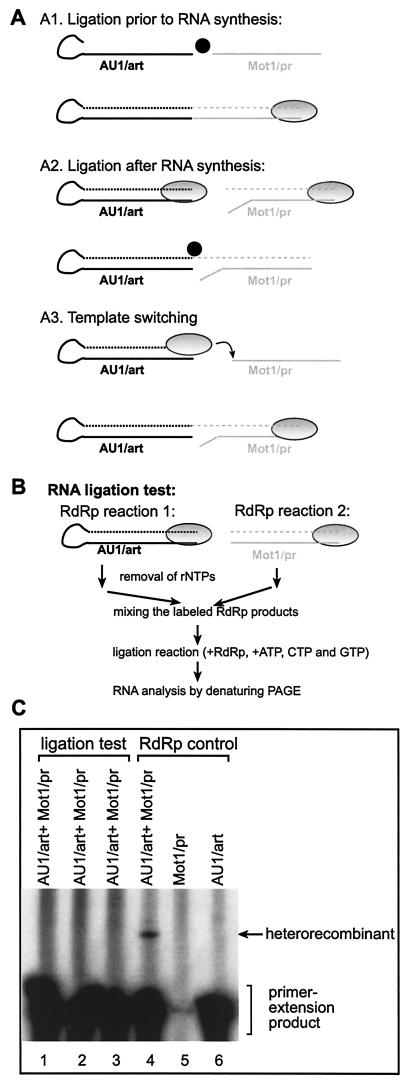FIG. 5.
Testing of whether the recombinants are generated by template switching or RNA ligation. (A) Schematic representation of the three most likely mechanisms that might lead to formation of recombinants shown in Fig. 1 to 4. (A1) If RNA ligation (due to RNA ligase activity, shown as a black circle) occurs between the two heterologous templates prior to RNA synthesis, then the RNA product synthesized by the RdRp (gray oval circle) would be approximately double or four times larger than the input templates (if initiation takes place via de novo initiation [data not shown] or primer extension [as indicated in the figure]). Since the observed recombinants were approximately three times larger than the input templates in the above experiments (Fig. 1 to 4), this mechanism cannot explain the observed recombinants in the in vitro system and it was not tested further. Dotted lines represent the newly synthesized labeled RNAs. (A2) If RNA ligation between the heterologous RNAs occurs after the RdRp completes RNA synthesis on the input templates, then, depending on ligation involving one strand (as shown) or two strands (data not shown), recombinants either three or four times larger than the input RNAs are generated. Note that RNA synthesis by the TCV RdRp must initiate de novo on the template in the right panel in order to generate a substrate for RNA ligation that could generate the recombinants observed in this work (Fig. 3C to E). Since this mechanism could potentially generate the correct-sized recombinants, we tested this possibility as described below for panel B. (A3) Recombinants may also be generated by template switching of the RdRp as shown, resulting in the correct-sized recombinants. (B) Schematic description of the procedure used to test RNA ligation in vitro. See details in Materials and Methods. Note that the RdRp products were labeled with [32P]UTP independently in reactions 1 and 2 (top). (C) Denaturing PAGE analysis of the RdRp products after the RNA ligation test. Samples in lanes 1 to 3 were prepared as shown in panel B, while samples in lanes 4 to 6 were obtained as for Fig. 3B. The ligation reactions were performed in the presence of 10 mM ATP (lane 1), 10 mM ATP, CTP, and GTP (lane 2), or no ribonucleotides (lane 3). The expected heterorecombination product is marked with an arrow.

